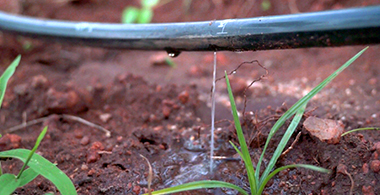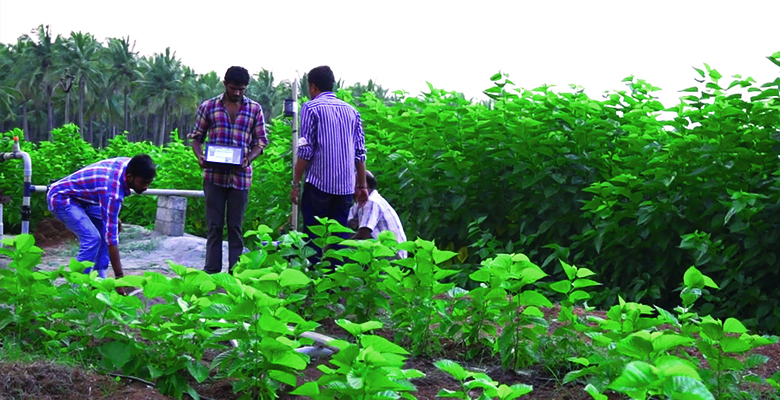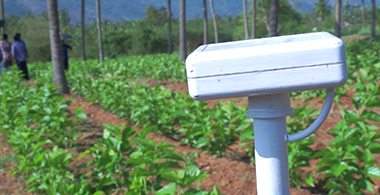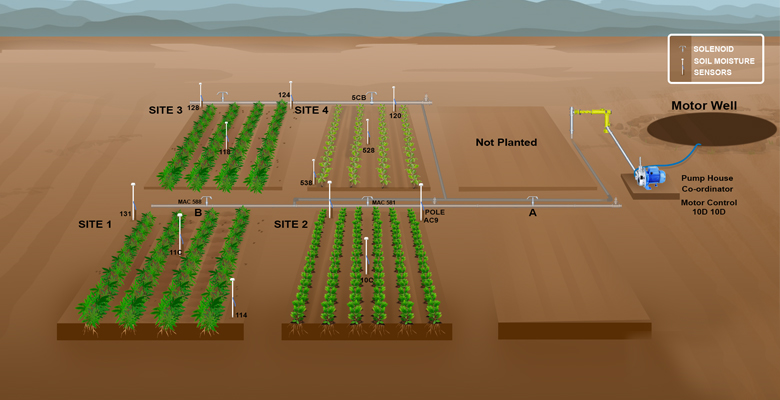Agriculture contributes around 15% of India’s GDP. Erratic electricity supply, varying voltage and non availability of adequate supply of water have added extra burden in irrigating their lands. Farmers end up trekking miles at night and/or stay awake in order to adequately irrigate their farm land. It is not a rare event that farmers leave the pumps to run throughout the night resulting in wastage of priceless water and electricity. It adds to the worry on already alarming depletion rate of ground water table.
KARSHAKA AMRITA DHARA (KAD)
Quantity of water needed for each crop vary with its growth stage and hence the irrigation system should auto adjust accordingly.KAD is the answer for all such worries. It provides a holistic automated irrigation solution for agriculture. Farmers do not even have to worry about adjusting their irrigation schedule based on the growth rate of the crop. KAD will have enough internal intelligence in itself to work out the exact quantity of water that the crop would need at any point of its growth. KAD uses soil moisture sensors, soil temperature sensors, Gate value control (GVC) units, Motor control Units (MCU) and IoT Decision support Gateway to sense and control the overall agriculture schedule. It uses Zigbee wireless protocol to control the irrigation schedules
IoT Gateway hosts the communication handling layer and also the KAD application. Application will wake up as per the schedule and will request the communication layer to interact with all the sensors participating in that schedule. Communication layer will ping each device thus waking them up from sleep state. Sensors are powered by solar energy. Since the sensors spend a majority of the time in sleep state, it requires less operating power. Gate Value controller is a device consisting of a simple motor and track wheel designed so that it can fit onto any existing gate values to control the flow of water through them. Gate valve controllers also run on solar power. Gate Valve controllers act as the routers for the sensor modules planted at the edge of the farm. Data from the edge nodes hop through the router nodes to reach the Gateway hosted near the MCU. Once the section of the farm where irrigation is active achieves the required saturation level, the gateway will turn on the next GVC turning off the previous one. Process continues till every section of the farm that is part of that schedule is completely irrigated successfully. Once all participating sensors respond to the ping from the Gateway, the application will ensure that minimum number of sensors required to start the cycle effectively is healthy and are ready to respond to requests from the Gateway. It will then read the soil moisture and soil temperature sensors and assess the current soil saturation level. Those section of the farm that have adequate soil moisture saturation (due to rain) will be dropped from the schedule. If the initial housekeeping cycle is successful, availability of power is checked for. If there is power and enough voltage then the gateway will initiate the schedule. It will turn on the first GVC in the planned schedule and then send the request to the pump to turn it on. Flow sensors will ensure that the pump is not on a dry run. If so the gateway will turn the motor off and put the current active schedule on standby mode. It will continue to make attempts to restart the schedule at regular intervals. Once started, the Gateway on a regular interval will ping the soil moisture sensors. Once the section 28 While in the middle of a schedule, if there happen to be a power outage, then the Gateway will restart the schedule once power is restored from where it was dropped off. Data from the Gateway is pushed back to the cloud for further analysis via GSM. Users also get to view details about the current and historic schedules through web and android interfaces. It also shows the current values of all the sensor in the farm. Gateway can also act as a hotspot for reconfiguring the gateway. For security reasons Gateway configuration parameters can be altered only when connected to it as a hotspot through an android app. User can connect to the hotspot and reconfigure the schedules.
AGRICULTURE SENSORS
Our Agriculture sensors include single and multilevel Soil Moisture (SM) sensors, Soil Moisture & Temperature (SMT) sensors, Gate Valve controller (GVC’s are cheaper solution to solenoids), Motor control Unit (MCU), Level sensors, Weather station and rain gauge. Soil moisture (SM) sensor provides the moisture concentration of the soil. Single level SM sensors are used for monitoring and controlling automated irrigation control systems. Multilevel SM sensors can give the farmers an idea about the moisture holding capacity of their soil. This can be used to map the field which can be of use to the farmer in deciding the right crop to be SM sensors are solar driven.For some crops especially vegetables it is not only important to monitor the moisture content of the soil but also need to keep close watch on the soil temperature as well. Such crops expects the temperature of the soil to be maintained at a certain level at all times. Current practise followed by the peasants to meet such requirements is to irrigate the land continuously. This usually results in wastage of electricity, water and also over irrigating the plants. Usually solenoids are expensive and in most instances will reduce the water pressure. Reduced water pressure in a drip irrigation system will result in a section of plants not receiving no/adequate water. Gate Valve controller (GVC) is an wirelessly controlled motor driven arm that can be positioned on top of existing gate valves that controls the flow of water to different irrigation zones within a farm. GVC’s will cost the farmer half the cost of conventional solenoids. Motor control Units (MCU) is an actuator that controls the water pump based on preconfigured irrigation cycles. Gateway will send appropriate commands to the MCU either to kick start an irrigation cycle or end an active cycle. Application hosted at the gateway will use sensor readings to decide when to initiate or to end an irrigation cycle When water is sourced from tanks that are replenished at regular intervals from bore wells or other water bodies it is important to sense the water level in the tank. Level sensors will constantly monitor the tank water level and ensure that it is topped up at required Weather stations and Rain gauges also picks up critical weather parameters that can supplement the decision making capability of the farmer.
Schematic Diagram
Automated Irrigation System
Technologies Used
.









